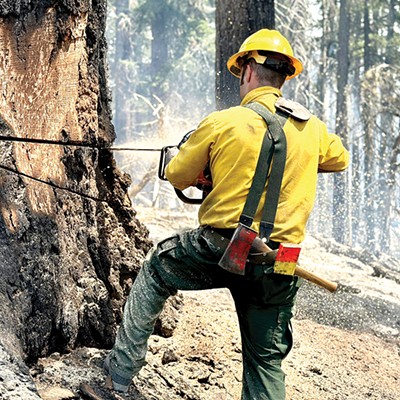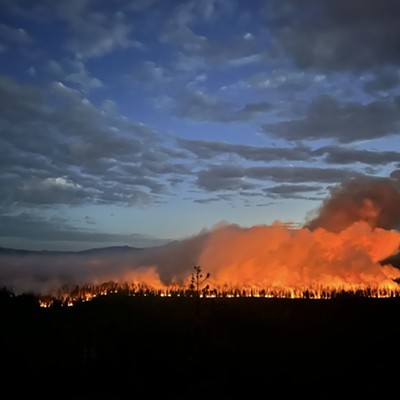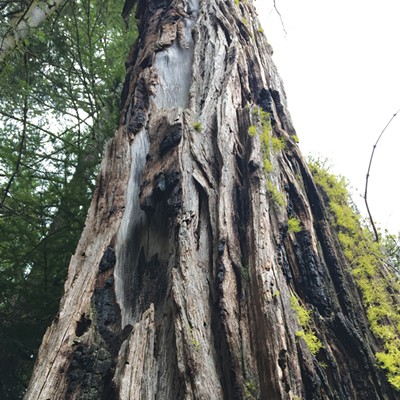On Sept. 12, 1944, the combined United States Pacific Fleet and Third Fleet started bombarding the Imperial Japanese Army on the tiny island of Peleliu, one of the 300 islands that make up the Republic of Palau about 1,000 miles east of the Philippines. U.S. Navy Aviation Ordinanceman First Class Anthony Di Petta, 24, was among those bombers, targeting antiaircraft weapons and transporter ships in a Grumen Avenger bomber. Japanese antiaircraft artillery struck Di Petta's plane, and for nearly 80 years Di Petta was considered missing in action until Project Recover, a nonprofit that repatriates fallen soldiers, confirmed his identity in January.
![Leave No Man Behind ▶ [With Video] (2)](https://media1.bendsource.com/bend/imager/u/blog/18857760/feature.jpg?cb=1680909823)
Di Petta moved from Italy to New Jersey when he was a child, where some of his family members remain to this day. Remaining family members will choose how to bury their long-lost relative, be it in a veterans' cemetery or a family plot.
"Whatever process they choose, they of course, have the option of having them receive full military honors," said Derek Abbey, the Bend-Based president and chief executive officer of Project Recover. "As you can imagine, this is very impactful and life-changing for the families to finally have answers to their loved one that was lost."
Since its formation, Project Recover has repatriated 17 veterans in 60 missions, though Abbey said those numbers are always changing as new investigations are opened and others are resolved. Dr. Pat Scannnon started Project Recover after aiding a team in 1994 that was searching for a Japanese ship downed by former U.S. President George H.W. Bush. After finding the ship ahead of schedule, Scannon enlisted a local guide to find more wreckage from the battle around the island. That guide took him to a 24-foot B-24 wing, and he felt determined to track down the rest of the plane and to learn the stories of the men who passed away inside it.
![Leave No Man Behind ▶ [With Video] (3)](https://media2.bendsource.com/bend/imager/u/blog/18857398/feature1-1-82a6b7558b5fd981.jpg?cb=1680909823)
"He took it upon himself to find out. He started doing research on Palau — realized all the major air campaigns and battles that took place, and how many people were still missing in and around Palau," Abbey said. "He started coming back to this nation by himself and realized very quickly when he was working in the jungles and waters around Palau, that this is probably more safely done with a group of people. And so, he created what was originally called the BentProp project."
The BentProp project formed in 2001 as a small team that scoured Palau with GPS devices and machetes, relying on witness testimony and eyesight to find one of the more than 200 U.S. aircrafts shot down during the battle. The organization changed names after partnerships with the Scripps Institute of Oceanography at the University of California-San Diego and the College of Earth, Ocean, and Environment at the University of Delaware expanded its capabilities.
Battle of Peleliu
U.S. forces advanced toward Peleliu after securing the Mariana Islands in August 1944, as part of a broader effort to recapture the Philippines from the Japanese Army. Marines suffered the highest casualty rate of any amphibious assault in World War II during the Battle of Peleliu. Of the 28,000 Marines that landed on Peleliu, 1,800 were killed, 5,142 were wounded and 73 were reported missing— about 40% of the invading force in total. It was also the start of a new strategy from Japan that focused on attrition rather than aggression, seeking to win by wearing down supply lines while continuing to inflict casualties.
![Leave No Man Behind ▶ [With Video] (6)](https://media1.bendsource.com/bend/imager/u/blog/18857402/feature1-5-a3c71c170ee470fe.jpg?cb=1680909823)
The 12,000 Japanese soldiers stationed on Peleliu learned from the U.S.'s successes while island hopping in the Pacific. Until then, the Imperial Army used unrelenting force while defending amphibious assaults, targeting landing vessels before they beached, but on Peleliu it opted for a defensive battle. Rather than attempting to stop forces as they came ashore, the defenders opted to use fortified bunkers, a system of caves and tunnels and the island's rough terrain to evade enemy fire. They also did away with costly swarming tactics, often called Banzai charges, and kamikaze attacks. The result was an average of 1,500 American shots fired per one Japanese casualty.
"The general public in the United States doesn't necessarily know about — they know a lot about the famous battles that took place in the Pacific like Iwo Jima, Okinawa and others like that," Abbey said. "There's a lot of debate over the years as to whether or not it was needed. Needless to say, those that fought and died here did so just as violently as any other battle in the Pacific. But there were a number of casualties and all those air campaigns as well as the amphibious landing. So, this was a very hot part of the Pacific."
![Leave No Man Behind ▶ [With Video] (4)](https://media2.bendsource.com/bend/imager/u/blog/18857399/feature1-2-8e034d9db793fd0c.jpg?cb=1680909823)
The Japanese Colonel in charge of defenses performed ritual suicide on Nov. 24, 1944. Three days later the Americans declared the island secure. Most Japanese soldiers characteristically refused to surrender, and nearly all of the 12,000-man defending force died during the battle. Twenty-six Imperial soldiers remained in the caves until April 1947, about a year and a half after Japan officially surrendered.
Bringing them home
A World War II veteran may have no living acquaintances. The youngest surviving World War II veteran Bob Kelso joined the Navy at the age of 13 in 1944 and is now 92 years old. But even without surviving friends, family and acquaintances, repatriation can change the lives of those who lost someone.
"My grandfather went missing on September 1, 1944. His wife, my grandmother, she never remarried, always kind of wondering if he might be coming home. That somehow, he might have lived. There were even rumors throughout extended branches of our family that he did live, and he was living somewhere else. My dad grew up, honestly, I think he wondered if his dad didn't ever want to come home. And that shaped him as he grew up," said Casey Doyle, a Marine Corps officer stationed out of Fort Lejune in North Carolina who has been in the service for 19 years.
![Leave No Man Behind ▶ [With Video]](https://media1.bendsource.com/bend/imager/u/blog/18857400/feature1-3-6feefab869af1ca2.jpg?cb=1680909823)
Doyle didn't know much about his grandfather growing up. By chance his parents saw an article about the BentProp Project and got in touch with the organization. Coincidentally, BentProp started searching for the plane Doyle's grandfather Jimmie went down in 10 years before the family got in touch. The Doyle family was able to help BentProp with identifying information. They discovered Jimmie Doyle's remains, his wedding ring still on his dog tags.
"It changed my father's life. It changed my entire family history, my family's stories to the last century. But it changed my father's perspective on everything he thought he knew about who he was and where it came from. It's life changing, it sounds kind of trite but really is," Doyle said.
From BentProp to Project Recover
What started as a volunteer team doing a yearly mission to Palau grew into a global search organization for American MIAs. The nonprofit has been in 21 different countries and is the only non-governmental organization that researches, searches for and recovers fallen soldiers. Its partnership with the Scripps Institute of Oceanography and Delaware Institute gives them access to sonar, autonomous underwater vehicles and 3D modelling technologies that advance their capabilities.
"This technology continues to grow at a rapid rate," Abbey said. "We can cover more space in greater detail at a much faster rate. We can also go deeper and have located sites at 1,000 feet of depth. Now we are facing the challenge of recovery at that depth. However, that capability also continues to improve."
Project Recover discovered a manmade impact in the floor using sonar technology on an underwater drone. It was identified as an Avenger, but it still took years to verify the identity of its inhabitants. It was located and documented in 2015, but for the next six years Project Recover couldn't confirm who was in the plane. The two other crew members remain unidentified.
"They'll do a blind identification using a number of means. Most people think about DNA and they do use DNA for that. But then they look at artifacts that might be commingled with the remains, such as dog tags or watches or rings or lifesaving equipment. They'll study skeletal remains. So, if somebody had broke their right arm when they were a child, and there's evidence of a broken right arm in the remains, that's more evidence that kind of narrows it down. They still use dental records, because dental records were very well kept. And then they'll triangulate all that data to come with 100% solution or as close to 100% solution as possible," Abbey said.
Though Project Recover investigates MIAs in any conflict, the greatest need remains for the soldiers of World War II. There are about 81,000 U.S. soldiers considered missing in action —72,000 are from World War II, 7,000 from Korea, 1,600 in Vietnam. Fewer than 50 Americans are designated missing in action from Operation Desert Storm and six are missing from the war in Iraq. The U.S. exited Afghanistan without a single MIA. The Defense POW/MIA Accounting Agency says about 75% of remaining POWs are in the Indo-Pacific.
"The evidence and the science is what drives our mission. We prioritize cases based on which has the highest likelihood of success. And we do that using a number of factors, resources available access to the area," Abbey said. As we build on a case, and more information shows itself — maybe there's another piece of data somewhere or an eyewitness — that brings data to us where we can build that case more and more. The more information that we have that can triangulate and minimize the search area, the easier it is for us to execute that mission with a higher likelihood of success."
The Recover Project's database includes 700 cases associated with about 3,000 missing Americans. The mission is global and its members are all over the country, but vital work for the project is being done in Bend. And sometimes, that work comes close to home.
"Our most recent repatriation before Di Petta was Paul Avolese. And Paul Avolese was located and recovered by Project Recover in Vietnam. He's buried in Springfield, Oregon, so not too far from Bend, just over the pass toward Eugene," Abbey said. "We've had a chance to go visit his grave site and honor him. But you know, I think it's important for the citizens of Bend to know, and the citizens of Central Oregon to know that, that this work is happening. And this is in their backyard. And this is every American's mission. So, we might be the ones that are working on it. But it's all of our mission. And it's all of our promise."

![Leave No Man Behind ▶ [With Video] (5)](https://media1.bendsource.com/bend/imager/u/blog/18857401/feature1-4-0a74eb2880f04c6f.jpg?cb=1680909823)
![Leave No Man Behind ▶ [With Video] (7)](https://media2.bendsource.com/bend/imager/u/blog/18857403/feature1-6-c1cf172c97c059b8.jpg?cb=1680909823)
























